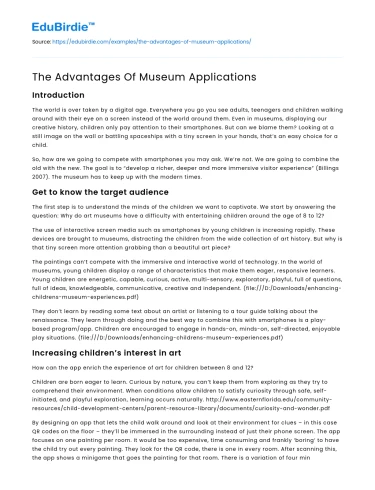Introduction
The world is over taken by a digital age. Everywhere you go you see adults, teenagers and children walking around with their eye on a screen instead of the world around them. Even in museums, displaying our creative history, children only pay attention to their smartphones. But can we blame them? Looking at a still image on the wall or battling spaceships with a tiny screen in your hands, that’s an easy choice for a child.
So, how are we going to compete with smartphones you may ask. We’re not. We are going to combine the old with the new. The goal is to “develop a richer, deeper and more immersive visitor experience” (Billings 2007). The museum has to keep up with the modern times.
Save your time!
We can take care of your essay
- Proper editing and formatting
- Free revision, title page, and bibliography
- Flexible prices and money-back guarantee
Get to know the target audience
The first step is to understand the minds of the children we want to captivate. We start by answering the question: Why do art museums have a difficulty with entertaining children around the age of 8 to 12?
The use of interactive screen media such as smartphones by young children is increasing rapidly. These devices are brought to museums, distracting the children from the wide collection of art history. But why is that tiny screen more attention grabbing than a beautiful art piece?
The paintings can’t compete with the immersive and interactive world of technology. In the world of museums, young children display a range of characteristics that make them eager, responsive learners. Young children are energetic, capable, curious, active, multi-sensory, exploratory, playful, full of questions, full of ideas, knowledgeable, communicative, creative and independent. (file:///D:/Downloads/enhancing-childrens-museum-experiences.pdf)
They don’t learn by reading some text about an artist or listening to a tour guide talking about the renaissance. They learn through doing and the best way to combine this with smartphones is a play-based program/app. Children are encouraged to engage in hands-on, minds-on, self-directed, enjoyable play situations. (file:///D:/Downloads/enhancing-childrens-museum-experiences.pdf)
Increasing children’s interest in art
How can the app enrich the experience of art for children between 8 and 12?
Children are born eager to learn. Curious by nature, you can’t keep them from exploring as they try to comprehend their environment. When conditions allow children to satisfy curiosity through safe, self-initiated, and playful exploration, learning occurs naturally. http://www.easternflorida.edu/community-resources/child-development-centers/parent-resource-library/documents/curiosity-and-wonder.pdf
By designing an app that lets the child walk around and look at their environment for clues – in this case QR codes on the floor – they’ll be immersed in the surrounding instead of just their phone screen. The app focuses on one painting per room. It would be too expensive, time consuming and frankly ‘boring’ to have the child try out every painting. They look for the QR code, there is one in every room. After scanning this, the app shows a minigame that goes the painting for that room. There is a variation of four minigames;
Find the differences
On the screen is a version of the painting, but there are 10 spots that differ from the original. When all 10 differences have been found the minigame is complete.
Classic puzzle
The painting gets divided in 10 puzzle pieces. The goal is to place them on the empty square, so they show the finished painting.
Sliding puzzle
The painting is divided in 9 squares. One piece is missing and it’s out of order. The goal is to slide the squares so they form the original painting.
Place the missing items
The screen shows a completely empty painting. Next to it are the objects and people. The goal is to look at the painting and place the missing items in the right spot.
All the minigames require the child to look at both their smartphone and the painting. If the challenge turns out to be too difficult and the child is struggling, they can get a hint. They get a question about the painting correlating with the current minigame. When answered correctly a hint is given. If the child enters a wrong answer, they can give it another try with a different question. There is no limited number of hints. The app will be made with the assumption that children from 8 to 12 can read and count to at least 20.
The app makes use of extrinsic motivation (being driven by external rewards) by giving points for completing the minigames. These points can be traded for toys in the souvenir shop.






 Stuck on your essay?
Stuck on your essay?

